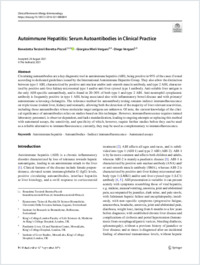Autoimmune hepatitis : serum autoantibodies in clinical practice
- Terziroli Beretta-Piccoli, Benedetta Epatocentro Ticino, Lugano, Switzerland - Institute for Research in Biomedicine (IRB), Faculty of Biomedical Sciences, Università della Svizzera italiana, Switzerland - King’s College London Faculty of Life Sciences &, Medicine At King’s College Hospital, London, UK
- Mieli Vergani, Giorgina King’s College London Faculty of Life Sciences &, Medicine At King’s College Hospital, London, UK - Paediatric Liver, GI and Nutrition Centre, MowatLabs, King’s College Hospital, London, UK
- Vergani, Diego King’s College London Faculty of Life Sciences &, Medicine At King’s College Hospital, London, UK - Institute of Liver Studies, MowatLabs, King’s College Hospital, London, UK
-
07.09.2021
Published in:
- Clinical reviews in allergy & immunology. - Springer. - 2022, vol. 63, p. 124–137
English
Circulating autoantibodies are a key diagnostic tool in autoimmune hepatitis (AIH), being positive in 95% of the cases if tested according to dedicated guidelines issued by the International Autoimmune Hepatitis Group. They also allow the distinction between type 1 AIH, characterized by positive anti-nuclear and/or anti-smooth muscle antibody, and type 2 AIH, characterized by positive anti-liver kidney microsomal type 1 and/or anti-liver cytosol type 1 antibody. Anti-soluble liver antigen is the only AIH-specific autoantibody, and is found in 20–30% of both type 1 and type 2 AIH. Anti-neutrophil cytoplasmic antibody is frequently positive in type 1 AIH, being associated also with inflammatory bowel disease and with primary/autoimmune sclerosing cholangitis. The reference method for autoantibody testing remains indirect immunofluorescence on triple tissue (rodent liver, kidney and stomach), allowing both the detection of the majority of liver- relevant reactivities, including those autoantibodies whose molecular target antigens are unknown. Of note, the current knowledge of the clinical significance of autoantibodies relies on studies based on this technique. However, immunofluorescence requires trained laboratory personnel, is observer-dependent, and lacks standardization, leading to ongoing attempts at replacing this method with automated assays, the sensitivity, and specificity of which, however, require further studies before they can be used as a reliable alternative to immunofluorescence; currently, they may be used as complementary to immunofluorescence.
- Language
-
- English
- Classification
- Medicine
- License
- Open access status
- hybrid
- Identifiers
-
- RERO DOC 333714
- DOI 10.1007/s12016-021-08888-9
- ARK ark:/12658/srd1319281
- Persistent URL
- https://n2t.net/ark:/12658/srd1319281
Statistics
Document views: 232
File downloads:
- Texte intégral: 372
